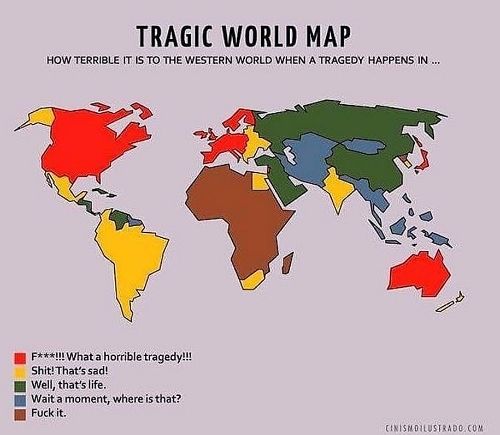I was skimming through twitter when I saw this graphic — which was from cinismo ilustrado originally, and it made me stop and think.
So much that feeds news cycles depends on when, where and to whom something happens.
The Nation had this article back in January “Lives Fit for Print: Exposing Media Bias in Coverage of Terrorism” which took a look at the coverage of European and American versus non-Western events.
… almost all of these largely unreported major terrorist attacks were in non-Western countries. Of the 26 incidents in which 50 or more people died, only one happened in the West—the November attack in Paris. Of the remaining 25, 13 were in Africa (with 9 in Nigeria alone) and 11 were in the Middle East (with 4 in Iraq).
Many non-Western countries are hit by smaller terror incidents all the time. Nigeria, for example, suffered from 40 terror attacks last year—one every week and a half—with a staggering aggregate death toll of 3,193.
Try to imagine, for a second, that since January of 2015 there had been 40 incidents of terrorism in the United States, and that in 9 of them, 50 or more people had died. If that’s hard to do, think about this instead: Conservative estimates suggest that Nigeria experienced more terror-related loss of life in 2015 than the United States did in 2001, the year of 9/11.
This media bias is not simply a matter of covering terrorism. We already know the bias around missing persons.
Dori Maynard, who died last year was the president of the Robert C. Maynard Institute for Journalism Education in Oakland, California.
One of her former students, Joshunda Sanders, has just published “How Racism and Sexism Killed Traditional Media: Why the Future of Journalism Depends on Women and People of Color”
We are well aware of the racial bias surrounding both the response to and reporting on Hurricane Katrina.
Grassroots social movements like #BlackLivesMatter, and #BringBackOurGirls have helped raise the media profile of national and international events, with the use of platforms like facebook and twitter, but mainstream media is still racist in the way it covers protest.
It isn’t simply a matter of tragedy either. Think of how sparse the coverage is for groups like the Moral Mondays Movement, which is spearheaded by a black organization, the NC NAACP.
We have to do better.
Suggestions?


The map makes me both sad and angry.
The map—so true, Denise. Thanks for this post. It really is revolting how white male privileged journos ignore people of color and the tragedies that happen to them.
There may never be an all-women’s news network, but I wish there were. If students of film and videography were to make YouTube videos about such tragedies, one supposes they would receive at least some “eyes.”
However, I can’t think of any remedies for this situation, unless a group of women forms a rapid-response team for Twitter or some comparable social medium to publicize news about other countries and the events that happen in them.
Sigh – I couldn’t think of anything either. The women who started the #BringBackOurGirls hashtag did force the issue onto the world stage – thankfully.
I used to see that kind of “meanwhile, in [name of country in the ‘well that’s life’ or ‘fk it’ group] 180 people were murdered in civil and ethnic strife” reporting (after a western nation was attacked by terrorists) on Al Jazeera America which shuttered early this year. Americans are force fed their news and if it does not involve white faces, it didn’t happen.
I am not sure how you make people care what is happening outside of their little reality-TV world. The best we can do is elect leaders who are not Eurocentric and hope that they can raise the level of awareness and keep aid going to places that need it. President Obama’s trip to Africa last year seemed to signal that he will be taking a larger role in promoting the “forgotten countries” after he leaves office. I hope so.
“if it does not involve white faces, it didn’t happen”
Yup. Ugly, sad and true.